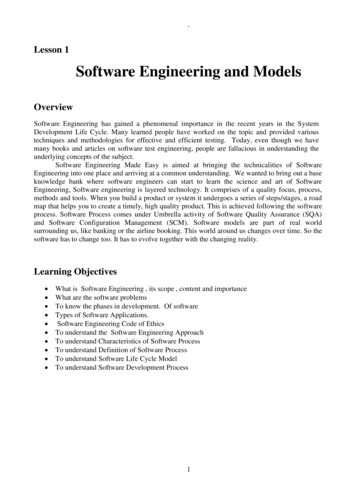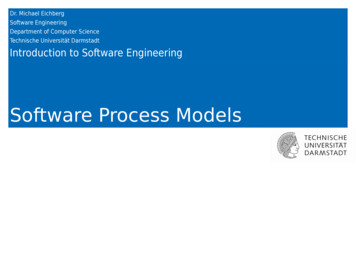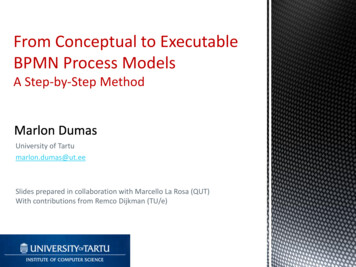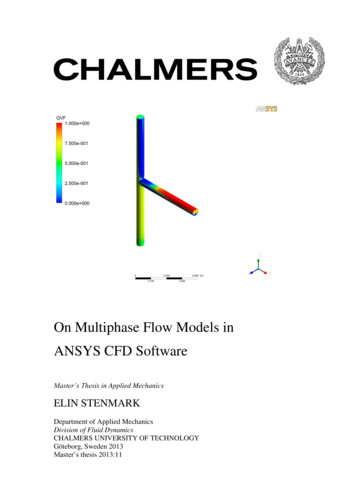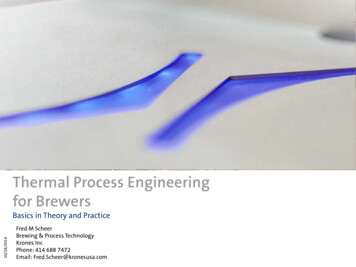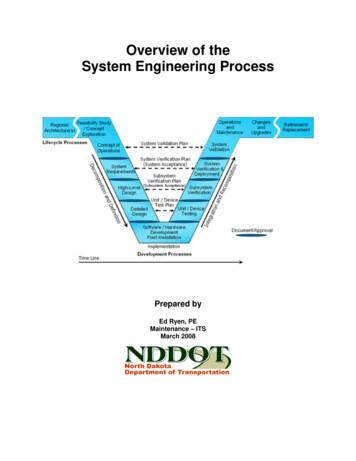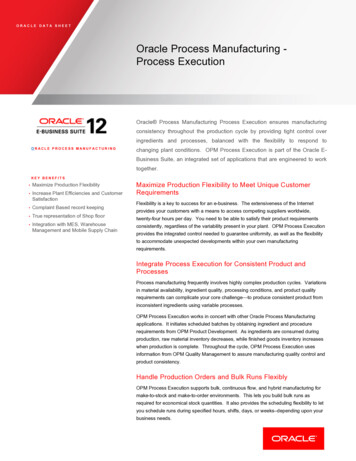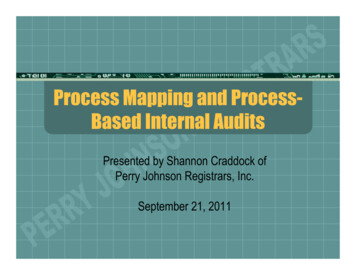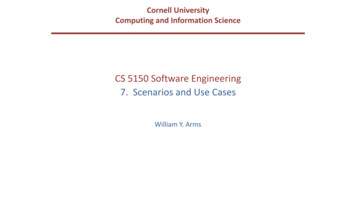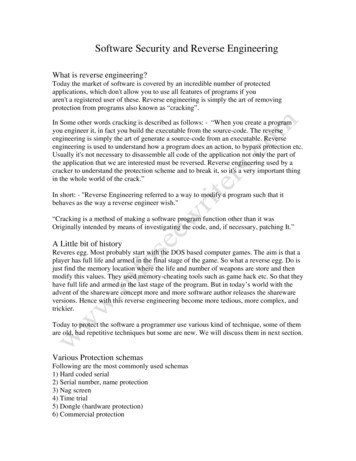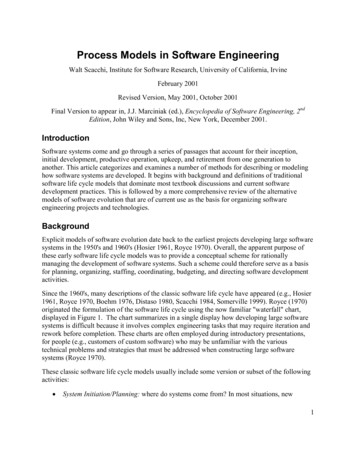
Transcription
Process Models in Software EngineeringWalt Scacchi, Institute for Software Research, University of California, IrvineFebruary 2001Revised Version, May 2001, October 2001Final Version to appear in, J.J. Marciniak (ed.), Encyclopedia of Software Engineering, 2ndEdition, John Wiley and Sons, Inc, New York, December 2001.IntroductionSoftware systems come and go through a series of passages that account for their inception,initial development, productive operation, upkeep, and retirement from one generation toanother. This article categorizes and examines a number of methods for describing or modelinghow software systems are developed. It begins with background and definitions of traditionalsoftware life cycle models that dominate most textbook discussions and current softwaredevelopment practices. This is followed by a more comprehensive review of the alternativemodels of software evolution that are of current use as the basis for organizing softwareengineering projects and technologies.BackgroundExplicit models of software evolution date back to the earliest projects developing large softwaresystems in the 1950's and 1960's (Hosier 1961, Royce 1970). Overall, the apparent purpose ofthese early software life cycle models was to provide a conceptual scheme for rationallymanaging the development of software systems. Such a scheme could therefore serve as a basisfor planning, organizing, staffing, coordinating, budgeting, and directing software developmentactivities.Since the 1960's, many descriptions of the classic software life cycle have appeared (e.g., Hosier1961, Royce 1970, Boehm 1976, Distaso 1980, Scacchi 1984, Somerville 1999). Royce (1970)originated the formulation of the software life cycle using the now familiar "waterfall" chart,displayed in Figure 1. The chart summarizes in a single display how developing large softwaresystems is difficult because it involves complex engineering tasks that may require iteration andrework before completion. These charts are often employed during introductory presentations,for people (e.g., customers of custom software) who may be unfamiliar with the varioustechnical problems and strategies that must be addressed when constructing large softwaresystems (Royce 1970).These classic software life cycle models usually include some version or subset of the followingactivities:·System Initiation/Planning: where do systems come from? In most situations, new1
feasible systems replace or supplement existing information processing mechanismswhether they were previously automated, manual, or informal.·Requirement Analysis and Specification: identifies the problems a new software system issuppose to solve, its operational capabilities, its desired performance characteristics, andthe resource infrastructure needed to support system operation and maintenance.·Functional Specification or Prototyping: identifies and potentially formalizes the objectsof computation, their attributes and relationships, the operations that transform theseobjects, the constraints that restrict system behavior, and so forth.·Partition and Selection (Build vs. Buy vs. Reuse): given requirements and functionalspecifications, divide the system into manageable pieces that denote logical subsystems,then determine whether new, existing, or reusable software systems correspond to theneeded pieces.·Architectural Design and Configuration Specification: defines the interconnection andresource interfaces between system subsystems, components, and modules in wayssuitable for their detailed design and overall configuration management.·Detailed Component Design Specification: defines the procedural methods through whichthe data resources within the modules of a component are transformed from requiredinputs into provided outputs.·Component Implementation and Debugging: codifies the preceding specifications intooperational source code implementations and validates their basic operation.·Software Integration and Testing: affirms and sustains the overall integrity of thesoftware system architectural configuration through verifying the consistency andcompleteness of implemented modules, verifying the resource interfaces andinterconnections against their specifications, and validating the performance of thesystem and subsystems against their requirements.·Documentation Revision and System Delivery: packaging and rationalizing recordedsystem development descriptions into systematic documents and user guides, all in aform suitable for dissemination and system support.·Deployment and Installation: providing directions for installing the delivered softwareinto the local computing environment, configuring operating systems parameters and useraccess privileges, and running diagnostic test cases to assure the viability of basic systemoperation.·Training and Use: providing system users with instructional aids and guidance forunderstanding the system's capabilities and limits in order to effectively use the system.· Software Maintenance: sustaining the useful operation of a system in its host/targetenvironment by providing requested functional enhancements, repairs, performance2
improvements, and conversions.What is a software life cycle model?A software life cycle model is either a descriptive or prescriptive characterization of howsoftware is or should be developed. A descriptive model describes the history of how a particularsoftware system was developed. Descriptive models may be used as the basis for understandingand improving software development processes, or for building empirically groundedprescriptive models (Curtis, Krasner, Iscoe, 1988). A prescriptive model prescribes how a newsoftware system should be developed. Prescriptive models are used as guidelines or frameworksto organize and structure how software development activities should be performed, and in whatorder. Typically, it is easier and more common to articulate a prescriptive life cycle model forhow software systems should be developed. This is possible since most such models are intuitiveor well reasoned. This means that many idiosyncratic details that describe how a softwaresystems is built in practice can be ignored, generalized, or deferred for later consideration. This,of course, should raise concern for the relative validity and robustness of such life cycle modelswhen developing different kinds of application systems, in different kinds of developmentsettings, using different programming languages, with differentially skilled staff, etc. However,prescriptive models are also used to package the development tasks and techniques for using agiven set of software engineering tools or environment during a development project.Descriptive life cycle models, on the other hand, characterize how particular software systemsare actually developed in specific settings. As such, they are less common and more difficult toarticulate for an obvious reason: one must observe or collect data throughout the life cycle of asoftware system, a period of elapsed time often measured in years. Also, descriptive models arespecific to the systems observed and only generalizable through systematic comparative analysis.Therefore, this suggests the prescriptive software life cycle models will dominate attention untila sufficient base of observational data is available to articulate empirically grounded descriptivelife cycle models.These two characterizations suggest that there are a variety of purposes for articulating softwarelife cycle models. These characterizations serve as a·Guideline to organize, plan, staff, budget, schedule and manage software project workover organizational time, space, and computing environments.·Prescriptive outline for what documents to produce for delivery to client.·Basis for determining what software engineering tools and methodologies will be mostappropriate to support different life cycle activities.·Framework for analyzing or estimating patterns of resource allocation and consumptionduring the software life cycle (Boehm 1981)·Basis for conducting empirical studies to determine what affects software productivity,cost, and overall quality.3
What is a software process model?In contrast to software life cycle models, software process models often represent a networkedsequence of activities, objects, transformations, and events that embody strategies foraccomplishing software evolution. Such models can be used to develop more precise andformalized descriptions of software life cycle activities. Their power emerges from theirutilization of a sufficiently rich notation, syntax, or semantics, often suitable for computationalprocessing.Software process networks can be viewed as representing multiple interconnected task chains(Kling 1982, Garg 1989). Task chains represent a non-linear sequence of actions that structureand transform available computational objects (resources) into intermediate or finished products.Non-linearity implies that the sequence of actions may be non-deterministic, iterative,accommodate multiple/parallel alternatives, as well as partially ordered to account forincremental progress. Task actions in turn can be viewed a non-linear sequences of primitiveactions which denote atomic units of computing work, such as a user's selection of a command ormenu entry using a mouse or keyboard. Winograd and others have referred to these units ofcooperative work between people and computers as "structured discourses of work" (Winograd1986), while task chains have become popularized under the name of "workflow" (Bolcer 1998).Task chains can be employed to characterize either prescriptive or descriptive action sequences.Prescriptive task chains are idealized plans of what actions should be accomplished, and in whatorder. For example, a task chain for the activity of object-oriented software design might includethe following task actions:·Develop an informal narrative specification of the system.·Identify the objects and their attributes.·Identify the operations on the objects.·Identify the interfaces between objects, attributes, or operations.·Implement the operations.Clearly, this sequence of actions could entail multiple iterations and non-procedural primitiveaction invocations in the course of incrementally progressing toward an object-oriented softwaredesign.Task chains join or split into other task chains resulting in an overall production network or web(Kling 1982). The production web represents the "organizational production system" thattransforms raw computational, cognitive, and other organizational resources into assembled,integrated and usable software systems. The production lattice therefore structures how asoftware system is developed, used, and maintained. However, prescriptive task chains andactions cannot be formally guaranteed to anticipate all possible circumstances or idiosyncratic4
foul-ups that can emerge in the real world of software development (Bendifallah 1989, Mi 1990).Thus, any software production web will in some way realize only an approximate or incompletedescription of software development.Articulation work is a kind of unanticipated task that is performed when a planned task chain isinadequate or breaks down. It is work that represents an open-ended non-deterministic sequenceof actions taken to restore progress on the disarticulated task chain, or else to shift the flow ofproductive work onto some other task chain (Bendifallah 1987, Grinter 1996, Mi 1990, Mi 1996,Scacchi and Mi 1997). Thus, descriptive task chains are employed to characterize the observedcourse of events and situations that emerge when people try to follow a planned task sequence.Articulation work in the context of software evolution includes actions people take that entaileither their accommodation to the contingent or anomalous behavior of a software system, ornegotiation with others who may be able to affect a system modification or otherwise altercurrent circumstances (Bendifallah 1987, Grinter 1996, Mi 1990, Mi 1996, Scacchi and Mi1997). This notion of articulation work has also been referred to as software process dynamism.Traditional Software Life Cycle ModelsTraditional models of software evolution have been with us since the earliest days of softwareengineering. In this section, we identify four. The classic software life cycle (or "waterfall chart")and stepwise refinement models are widely instantiated in just about all books on modernprogramming practices and software engineering. The incremental release model is closelyrelated to industrial practices where it most often occurs. Military standards based models havealso reified certain forms of the classic life cycle model into required practice for governmentcontractors. Each of these four models uses coarse-grain or macroscopic characterizations whendescribing software evolution. The progressive steps of software evolution are often described asstages, such as requirements specification, preliminary design, and implementation; these usuallyhave little or no further characterization other than a list of attributes that the product of such astage should possess. Further, these models are independent of any organizational developmentsetting, choice of programming language, software application domain, etc. In short, thetraditional models are context-free rather than context-sensitive. But as all of these life cyclemodels have been in use for some time, we refer to them as the traditional models, andcharacterize each in turn.Classic Software Life CycleThe classic software life cycle is often represented as a simple prescriptive waterfall softwarephase model, where software evolution proceeds through an orderly sequence of transitions fromone phase to the next in order (Royce 1970). Such models resemble finite state machinedescriptions of software evolution. However, these models have been perhaps most useful inhelping to structure, staff, and manage large software development projects in complexorganizational settings, which was one of the primary purposes (Royce 1970, Boehm 1976).Alternatively, these classic models have been widely characterized as both poor descriptive andprescriptive models of how software development "in-the-small" or "in-the-large" can or shouldoccur. Figure 1 provides a common view of the waterfall model for software developmentattributed to Royce (1970).5
Figure 1. The Waterfall Model of Software Development (Royce 1970)Stepwise RefinementIn this approach, software systems are developed through the progressive refinement andenhancement of high-level system specifications into source code components (Wirth 1971, Mili1986). However, the choice and order of which steps to choose and which refinements to applyremain unstated. Instead, formalization is expected to emerge within the heuristics and skills thatare acquired and applied through increasingly competent practice. This model has been mosteffective and widely applied in helping to teach individual programmers how to organize theirsoftware development work. Many interpretations of the classic software life cycle thus subsumethis approach within their design and implementations.Incremental Development and ReleaseDeveloping systems through incremental release requires first providing essential operatingfunctions, then providing system users with improved and more capable versions of a system atregular intervals (Basili 1975). This model combines the classic software life cycle with iterativeenhancement at the level of system development organization. It also supports a strategy to6
periodically distribute software maintenance updates and services to dispersed user communities.This in turn accommodates the provision of standard software maintenance contracts. It istherefore a popular model of software evolution used by many commercial software firms andsystem vendors. This approach has also been extended through the use of software prototypingtools and techniques (described later), which more directly provide support for incrementaldevelopment and iterative release for early and ongoing user feedback and evaluation (Graham1989). Figure 2 provides an example view of an incremental development, build, and releasemodel for engineering large Ada-based software systems, developed by Royce (1990) at TRW.Elsewhere, the Cleanroom software development method at use in IBM and NASA laboratoriesprovides incremental release of software functions and/or subsystems (developed throughstepwise refinement) to separate in-house quality assurance teams that apply statistical measuresand analyses as the basis for certifying high-quality software systems (Selby 1987, Mills 1987).Industrial and Military Standards, and Capability ModelsIndustrial firms often adopt some variation of the classic model as the basis for standardizingtheir software development practices (Royce 1970, Boehm 1976, Distaso 1980, Humphrey 1985,Scacchi 1984, Somerville 1999). Such standardization is often motivated by needs to simplify oreliminate complications that emerge during large software development or project management.From the 1970's through the present, many government contractors organized their softwaredevelopment activities according to succession of military software standards such as MIL-STD2167A, MIL-STD 498, and IEEE-STD-016. ISO12207 (Moore 1997) is now the standard thatmost such contractors now follow. These standards are an outgrowth of the classic life cycleactivities, together with the documents required by clients who procure either software systemsor complex platforms with embedded software systems. Military software system are oftenconstrained in ways not found in industrial or academic practice, including: (1) required use ofmilitary standard computing equipment (which is often technologically dated and possesseslimited processing capabilities); (2) are embedded in larger systems (e.g., airplanes, submarines,missiles, command and control systems) which are mission-critical (i.e., those whose untimelyfailure could result in military disadvantage and/or life-threatening risks); (3) are developedunder contract to private firms through cumbersome procurement and acquisition procedures thatcan be subject to public scrutiny and legislative intervention; and (4) many embedded softwaresystems for the military are among the largest and most complex systems in the world (Moore1997). Finally, the development of custom software systems using commercial off-the-shelf(COTS) components or products is a recent direction for government contractors, and thusrepresents new challenges for how to incorporate a component-based development into theoverall software life cycle. Accordingly, new software life cycle models that exploit COTScomponents will continue to appear in the next few years.7
Figure 2. An Incremental Development, Build, and Release Model (Royce 1990)8
In industrial settings, standard software development models represent often provide explicitdetailed guidelines for how to deploy, install, customize or tune a new software system release inits operating application environment. In addition, these standards are intended to be compatiblewith provision of software quality assurance, configuration management, and independentverification and validation services in a multi-contractor development project. Early efforts inmonitoring and measuring software process performance found in industrial practice appear in(Humphrey 1985, Radice 1985, Basili 1988). These efforts in turn help pave the way for whatmany software development organizations now practice, or have been certified to practice,software process capability assessments, following the Capability Maturity Model developed bythe Software Engineering Institute (Paulk 1995) (see Capability Maturity Model for Software).Alternatives to the Traditional Software Life Cycle ModelsThere are at least three alternative sets of models of software development. These models arealternatives t
Process Models in Software Engineering Walt Scacchi, Institute for Software Research, University of California, Irvine February 2001 Revised Version, May 2001, October 2001 Final Version to appear in, J.J. Marciniak (ed.), Encyclopedia of Software Engineering, 2nd Edition, John W
